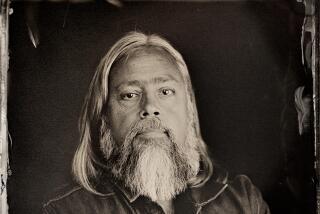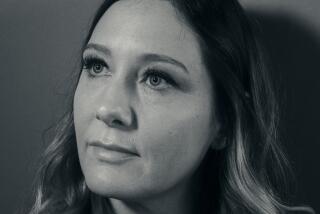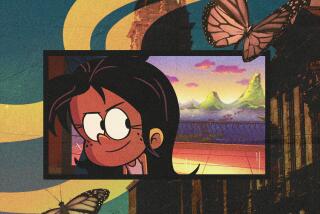Native Truths
- Share via
Native American writer Greg Sarris laments that most features and TV films dealing with Indians these days focus on historical “dead” males. “We have had three Ishi movies, three Geronimos and two Crazy Horses,” says Sarris. “The big question is, what happened to those of us who lived?”
The answer can be found in HBO’s “Grand Avenue,” premiering at 8 tonight. Adapted by Sarris from his novel, the movie focuses on the challenges facing three Native American families living in Santa Rosa in northern California.
There’s Mollie (Sheila Tousey), an alcoholic single mom trying to raise her three children away from the reservation. Her cousin Anna (Jenny Gago) is trying to salvage her marriage while her daughter is suffering from cancer. And high school teacher Steven (A Martinez) wants a better life for his pregnant second wife (Irene Bedard) and his son (Alexis Cruz)--but he finds his life in turmoil when Mollie, his high school sweetheart, returns to the old neighborhood.
“There are a lot of firsts here,” says co-executive producer Sarris, who was raised in Santa Rosa and is of Coastal Miwok Indian, Pomo Indian, Filipino, Jewish and Irish heritage. “This is the first drama about contemporary Indian people. An Indian wrote the book. An Indian wrote the teleplay and an Indian produced it. It is the first drama that features a lot of [Indian] women. And it’s the first drama that has anything to do with California Indians. Everybody probably thinks Ishi was the last California Indian.”
Directed by Daniel Sackheim, “Grand Avenue” also is the first TV project for Robert Redford and his partner, Rachel Pfeffer, who are both executive producers. Paul Aaron, who produced “Laurel Avenue,” HBO’s acclaimed 1994 drama about a middle-class black family, also is an executive producer of “Grand Avenue.”
“What I wanted to do was find a piece of material which dealt with contemporary Indian life and, particularly, contemporary urban Indian life,” Aaron says. “I wanted to do a series of pieces which are kind of walks down various streets in America ‘we’ would not normally find ourselves in. ‘We’ being the vast majority.”
Most Americans, Aaron says, still envision Indians as wearing buckskin, moccasins and war paint. “We still live in that kind of sensibility,” Aaron acknowledges.
Sarris, a UCLA English professor, explains that “since we were defeated 200 years ago, we have either been [portrayed as] a noble savage or a barn burner. So now we are the noble savage again. That’s good, I guess, but it’s the same old thing.”
In “Grand Avenue,” Sarris says, he is “showing people who happen to be Indians. They are people like you and me. Anybody can get into these people. They have the same desires and motivations as anybody.”
Sheila Tousey, who is a Menominee Indian from northern Wisconsin, has been longing for a project like “Grand Avenue” to come along. “What I have always waited for was to see a family of Indian people sitting down at a dinner table having dinner and having fights and seeing something contemporary,” Tousey says. “When I got the script it was like, ‘My God, it’s finally here.’ ”
Indians, Tousey says, are sort of an invisible people. “There are a lot of Indians in this country, and people have no idea what to expect from us,” she says. “I think that’s the reason why it’s difficult to find an audience for native pieces. People know what to expect when it is a western--when they see us in buckskin. But anything past starting in the 1900s, it’s not that they lose interest, it’s they don’t know what to expect.”
“Grand Avenue” really hit home for Dianne Debassige. The young actress plays the rock-solid second daughter, Alice, who becomes very involved in Indian culture when she moves to Santa Rosa.
An Ojibway Indian from Canada’s Lake Huron, Debassige’s own mother is an alcoholic single parent like Mollie.
“It was actually therapeutic [to make the movie],” she says. “I let my mother read the script before I went down [to do the film] to give her an idea of what kind of story it was. She cried. She was really emotionally affected by the story, probably because so much of it rang true.”
Debassige also “found a lot of strength from the Alice character. And at a perfect time in my life, too. I was really beginning to feel as if I wasn’t capable of being so strong. I was young and I was beginning to wither, but I found new strength.”
The film was shot on Grand Avenue in Santa Rosa. “It was so amazing,” Sarris says, laughing. “I have, like, 2,000 relatives up there, and I have published four books and maybe three of them have read any of my books. But boy, you mention Hollywood and they are all out there. That’s one of the reasons I did this, by the way. It’s the thing that got my people’s attention. It will build self-esteem.”
Sarris says that more than 300 local Indians worked on the movie. “A lot of my relatives have speaking parts,” he says. “They are all movie stars. We did have Indians working in the office and we had them behind the scenes everywhere. All of our stand-ins were local Indians.”
He says he hopes audiences will see the residents of “Grand Avenue” as “complex, everyday real characters in the multicultural flux in which we live. A Martinez’ character is half-Mexican. Mollie’s cousin is half-Mexican who is married to a Mexican. Alice is dating a black guy. My mother was Jewish. Ultimately, if this goes to series, what I want to do is open it up to the whole town and show us in the extended multicultural mix. I really want my people to be layered people like you and me.”
“Grand Avenue” airs Sunday at 8 p.m. on HBO.
More to Read
The complete guide to home viewing
Get Screen Gab for everything about the TV shows and streaming movies everyone’s talking about.
You may occasionally receive promotional content from the Los Angeles Times.







